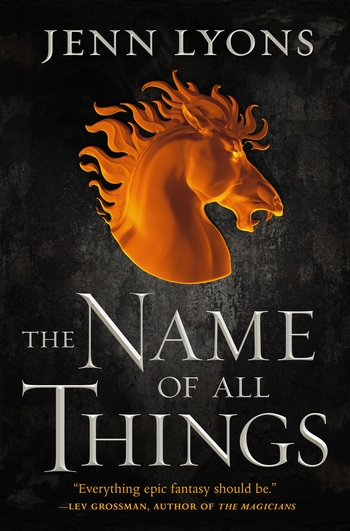Note: Jenn Lyons’s first book Ruin of Kings was such a hit with Geekly readers that we wanted to do even more to showcase her second book, The Name of All Things. And as Josh MacDougall pointed out, there are two narrators for this second volume, so what better than two reviews and two extras–an interview and a post-read discussion–to celebrate this too-awesome two-book extravaganza? Below is the first review. Get excited!
Not since Harry Potter have I closed a tome of this immense size with such a sigh of regret about its length. How can almost 600 pages feel so short? But it does. And the wait for the next book feels just as terribly long. I just wish there had been a midnight release so I could talk to many more people about how much I enjoy this series—and maybe some themed cupcakes based on the Cornerstones instead of the Hogwarts houses.
But Lyons isn’t the next J. K. Rowling. For starters she’s not in childrens/YA, to say nothing of her very different setting, characters, and thematic goals. No, Jenn Lyons is this generation’s David (and Leigh) Eddings.

If you don’t know the Eddings, they’re a husband and wife duo most famous for The Belgariad and The Mallorean, sweeping fantasy epics with large casts that traipsed around dozens of countries and multiple continents searching for stones of power and trying to defeat evil wizards and gods. They had a refreshing and (for the time) unusual dry humor, since unlike Tolkienian ripoffs they didn’t trip over their own gravitas. Lyons is the same, her humor tongue-in-cheek and her world utterly immense. There’s even a clever reference to another horse-focused culture, that of the Algar in The Belgariad. Both even have cities that exist primarily as traps for enemies, albeit in inverse ways. But that’s a particularly deep cut I don’t think it’s worth explaining. If you don’t know what I’m talking about (a) read the Belgariad, and (b) just know that it’s extremely clever.
Lyons is clearly steeped in SFF far beyond Eddings, though, and her expertise shows. There’s nary a cliché to be found: Lyons has thought and thought about everything she puts on the page, adding layers of politics and social critique to the incredible action sequences and character journeys. But the writing feels off the cuff and fresh, not belabored, an impressive feat.
Like Ruin of Kings, this book follows a similarly unconventional structure for its storytelling. However, instead of trading the POV between the past and present of a single character, this story is told by two characters alternating their own takes on the story they share, one in first person and one in third.
The third-person account comes from Brother Qown, a cleric assigned to serve Janel. He thought he was getting a cushy assignment to pray for and occasionally heal a count; he actually got sucked into Joratese politics, banditry, conspiracies, and probably the end of the world. Poor Qown! But he’s a lot sturdier and more interesting than he gives himself credit for, and his progress throughout the book (and especially at the end) is really great character work.
The first person account comes from Janel, the count of Tolamer, who is in dire financial straits and also trying to fend off an unwanted engagement. She’s up against a lot, but she also has some staunch allies and some remarkable abilities. Due to a traumatic possession by a demon at a young age, manifested several gifts. She’s unbelievably strong and sturdy (think STR 19 CON 19), so much so that she has to be careful not to accidentally crush her cups when she drinks or splinter doors when she closes them. It’s so refreshing to see a woman as the bruiser without her being a total brute.
Although, a note on her sex/gender: Janel identifies as a stallion. Jorat is a nation obsessed with its horses, and even their notions of gender take more from horses than from humans. Stallions are humans who are guardians, combatants, and leaders, while mares are teachers, supporters, and crafters. Stallion/mare is different from biological sex, just as we know that gender is different from sex in our own culture. But just like here on earth, people do insist on being dicks about it. Janel’s unwanted fiancée thinks he can force her to be a mare, which sets off a chain of events that sees multiple towns destroyed, the Duke of Jorat threatened, and not one but three dragons unleashed on the populace.
Moral of the story? Respect people’s pronouns.
I love the Jorat culture. I love that the people of Jorat wear their hair in laevos, long mohawks that mimic a horse’s mane. I love that they have patches, stars, dapples, and colorings like horses. I love the concept of idorra and thudaje, the loosely lord/vassal concept that mutually enforces power between the rulers and the ruled, rather than just letting rulers walk all over their subjects (theoretically). And I love that there are firebloods, omnivorous horses who can talk and whom all Joratese can understand. With every new step into Jorat, with every next page, there’s just more to love.
And the book doesn’t stay in Jorat the whole time, which might have been disappointing except that the other places Janel visits are also amazing. She’s in the afterlife fighting demons! She’s in Yor dealing with an ice-bound mountaintop culture with witches and women-haters! Her journey is long, complex, and incredible. This absolutely demolishes any fears of sophomore slump that might have been floating around. It’s just as—if not slightly more—incredible as Kihrin’s journey in Ruin of Kings. I am already chomping at the bit to see what more Jenn Lyons can throw at us.
The Name of All Things will be released October 29.
